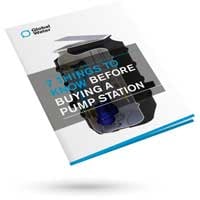What is a Sump Pump?
Sump Pumps are an effective device that drains away excess stormwater. The information below will help you understand what their purpose is and how they effectively manage stormwater.

What is a Sump Pump?
A Sump Pump is a form of Stormwater Pump Station designed to collect surface water and pump it to higher ground. A sump pump is categorised by having a grate at the top of the chamber, to collect the surface water, with a submersible drainage pump that sits inside the chamber. These devices are installed when gravity drainage from a typical grated inlet pipe is not possible. Applications for Sump Pumps include open stormwater collection areas like car parks, driveways, and gardens. Sometimes they can be used in enclosed area applications like underground car parks and basements where some surface water (or potentially groundwater) is expected.
How the Sump Pump Works
Drainage sump pumps are designed to transfer and dispose of stormwater. Here’s the process of how they work:
-
Collection pit:
The sump pump is placed within the sump pit (also known as the chamber), which is installed and located in the lowest part of the gravity drainage system. The lowest part of the property at surface may not be the lowest point in the gravity pipework underground. A grated inlet pit is designed to collect excess groundwater. Such groundwater is collected from the agg drain (slotted pipe) from around the outside of the basement, underground car park, or basements. Once collected, the groundwater is then fed via a gravity system to the Sump Pump pit.
-
Float activation:
Sump pumps are often equipped with a float switch level sensor that, when in a vertical position, engages the pump. (insert image of vertical float, diagram) The float has a metal ball inside it so as the water level in the sump pump pit rises to a predetermined height, the ball slides into place, connecting the electrical circuit inside the float, thus engaging the pump. The pumps disengage when the float is in the hanging position, indicating the water level has reduced.
-
Pumps engaged:
Once engaged, the sump pump then energises the stormwater from the collection pit through a pressurised discharge pipe called the rising main, allowing water to overcome gravity and flow uphill. A non-return valve must be installed into the discharge line, as it prevents backflow returning into the pit after the pump disengages. Backflow occurs once the water is no longer energised, following the natural gradient of the rising main (due to gravity) back towards the sump pump.
Choosing and Maintaining Your Sump Pump
To choose the right sump pump for your project, you must understand the drainage requirements such as the catchment area, volume of water needing to be handled, and the frequency and intensity of rain events. These factors help the estimator/designer to calculate the sump pumps inflow and outflow of stormwater. Ideally the inflow should be the same or greater than the outflow, but if not, then the capacity will need to be calculated. Capacity refers to the maximum volume of water or liquid that can be held, in this case inside the sump chamber before it reaches its full level. This is typically measured in litres.
Most sump pumps are designed to be set and forget systems as they have warning alarms or controllers if an issue was to arise. If the sump pump is in a high risk area then regular maintenance such as electrical inspections can be performed. Such inspections are not preventative measures however they may detect premature signs of failure.
For more information, get in touch with the Global Water team for assistance, or explore our sump pump range.
Tags: Submersible pumps




